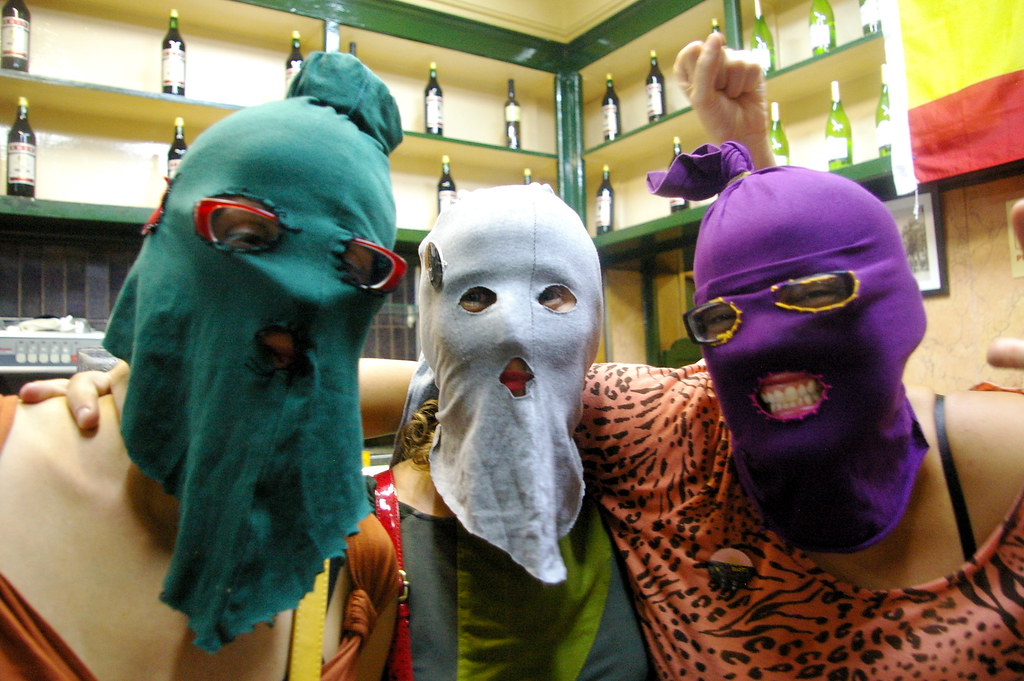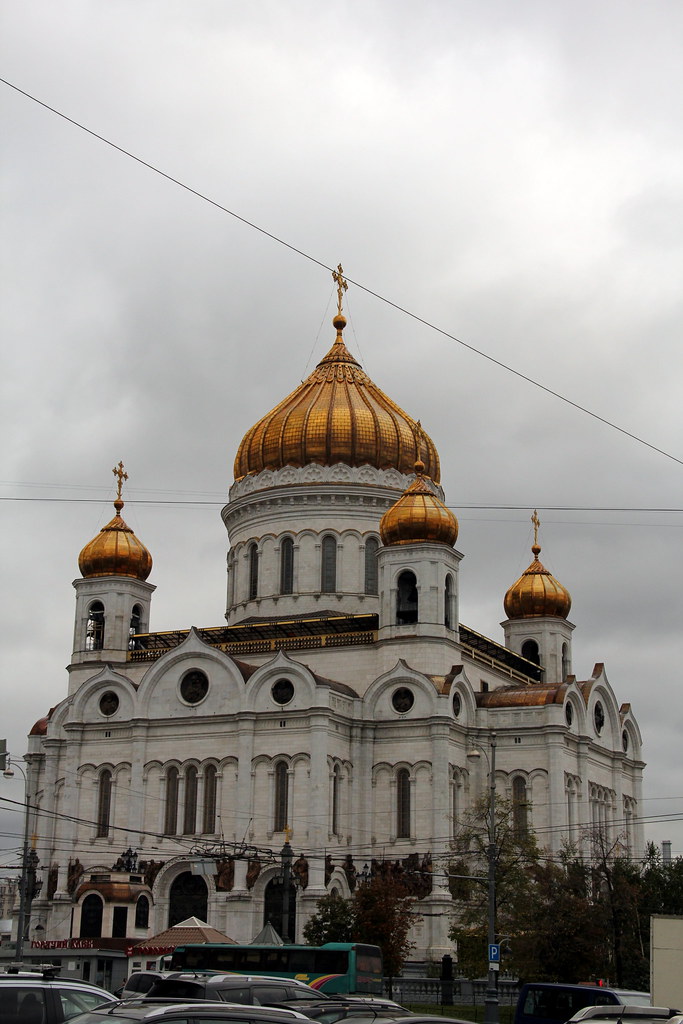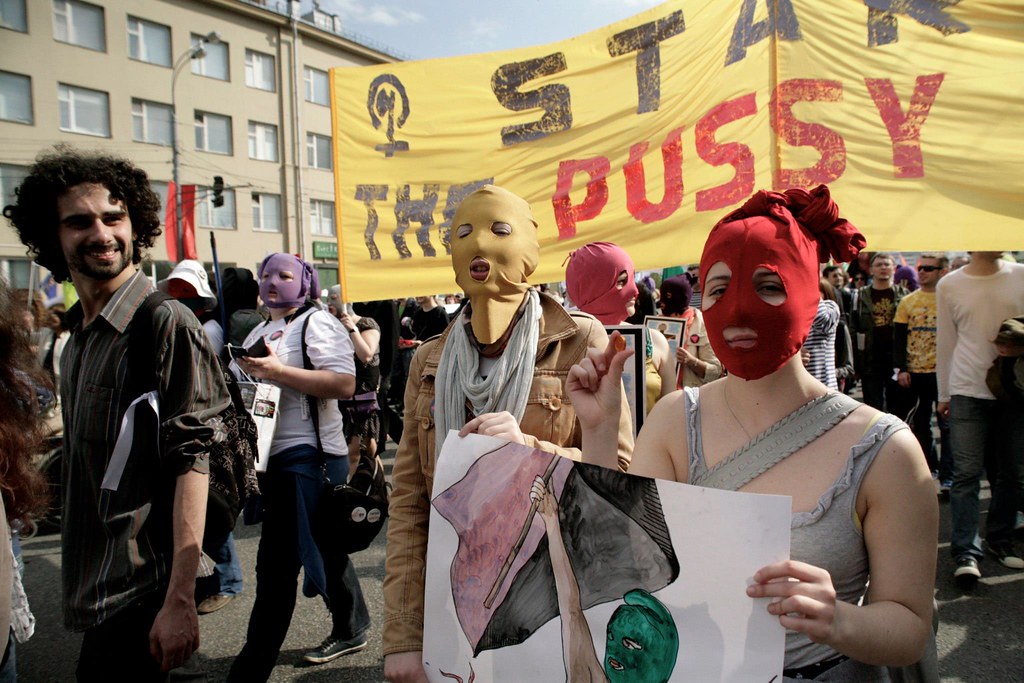Russia probably is not the country which comes to mind when thinking about punk music; but Pussy Riot is one Russian band that is known across the world, first of all because of the group’s distinct appearance which includes wearing balaclavas and clothing in as many colors as possible, and secondly because of the media attention it received, including an appearance of two members in the Netflix show “House of Cards”.
The band was founded in 2011 and emerged from the art group Voina. Pussy Riot set off by staging punk rock performances in public places in Russia – in the metro, on rooftops and on the Red Square for example. The band first landed international headlines in February 2012 when they attempted to perform their song “A Punk Prayer” in the Cathedral of Christ the Savior in Moscow. Back then, their performance was aimed at criticizing the relationship between the Orthodox church in Russia and Vladimir Putin’s election campaign as the church embraced Putin as a candidate for the presidency. Even though the performance was interrupted and didn’t take place the way it was planned, a cut-together video was later uploaded on YouTube with the title “Punk Prayer – Mother of God, Chase Putin Away!” and was seen worldwide. One year later a documentary called “Pussy Riot – A Punk Prayer” about the band and the trial, which followed the performance, was published.
However, perceptions of Pussy Riot remain ambiguous and encourage us to take a closer look.

Between punk band and performance activism
After the trial following the attempted performance in Moskov in 2012, Pussy Riot received solidarity from queer-feminist punk bands, Riot Grrrls members and other celebrities like Madonna. This put the musical aspects of the collective in the foreground. Pussy Riot was specifically set in the punk context as the genre traditionally focuses on criticizing state power which was and still is one of the main objectives of the group. However the performances that took place were less about music and a lot more about intervention and interruption in relation to the location of the performance. For example in 2011, the performance “Death to prison, freedom to protest” took place in front of a prison where political activists were being held after demonstrating against the results of national elections.
Pussy Riot is affiliated with Russian political artist collectives like Bombily, Chto delat? and MediaUdar. More broadly their usage of the balaclavas has also been connected to non-Western feminisms like the Chiapas movement. Members of the Chiapas movement cover their faces with balaclavas to avoid the development of personality cults.To add another view, apart from Pussy Riot being described as a punk band and a collective of performance activists, the group’s work is also described as media art,as every performance is later edited and spread on the internet in various forms.

Between individual personification and collective
The second aspect which presents a dichotomy in relation to Pussy Riot is the tension between individual’s being in the center of attention and the group’s goal to not have a personality cult. The group states that:
“We are anonymous, because we act against any personality cult, against hierarchies implied by appearance, age and other visible social attributes. We cover our heads, because we oppose the very idea of using female face as a trademark for promoting any sort of goods or services”.
https://pussy-riot.livejournal.com/ – Pussy Riot Blog 2014
The dress code of Pussy Riot has been the object of debate, but as previously mentioned, it allows the group to perform as collective and to not fall into individualizing the group and its media presence. Although not allowing individual personification was Pussy Riot’s goal, after the trial in connection to “A Punk Prayer”,the arrest of Nadezhda Tolokonnikova, Maria Alekhina and Yekaterina Samutsevich, put them in the international spotlight. This directly went against the collective’s agenda and was extensively promoted by international media.
Between Western Gaze and Russian political sphere
The third ambiguity that I came across exists between the Western Gaze and Western (white) feminism on the one hand and Russian feminist perspectives. This too can be exemplified by looking at what happened after “The Punk Prayer” in the Cathedral of Christ the Savior: In Western discourses the performance was soon labeled as a queer-feminist punk performance and ascribed punk values. This includes anti-religious sentiments. From a critical point of view, this can be seen in the setting of what is sometimes called a New Cold War in which – among other things – a divide is created between the progressive and secularized West and a non secularized, religious and dogmatic Other, namely Russia. Therefore counter-hegemonic collectives like Pussy Riot are seen as rising up against state-values like religion.
But when looking closely at the group’s activism it is observable that they don’t promote anti-religious sentiments. What they do criticize is the commercialization of religion and how it is used as a facade for generating profit. The collective notes that religion can be the oppressor’s tool, but it can also be a way of empowerment and they acknowledge that there are religious as well as non-religious members of Pussy Riot.
Furthermore the title of the video uploaded after the church performance was “Punk Prayer – Mother of God, Chase Putin Away!” and they reclaim Mary as a feminist figure. The activists even explained that performing in the altar area of the church was aimed at raising awareness to the issue that women are not permitted in this area of Orthodox churches and not even Mary would be allowed to go there.
Overall this demonstrates that the values which are often connected to Western queer-feminist punk related groups, have to be viewed differentiated in Non-Western contexts.

Conclusion – More balaclava or House of Cards?
This brief introduction to Pussy Riot demonstrated that the group exists in betweens and can hardly be analyzed from a singular perspective. It is therefore important to consider local and national Russian contexts when looking at the collective’s activism. There has been tensions between its status as a band or as a political performance group, between acting as a collective and individuals getting into the media spotlight and lastly between a Western view of the group and their activism in the current Russian framework.
Regardless of all those dichotomies what goes without questioning is that Pussy Riot had and has a crucial influence on Russian feminist discourses and if you haven’t heard of them so far I hope you’ll open Spotify, YouTube, Deezer or any other music streaming provider now and start listening to their songs!
Further Readings
Wiedlack, K. and Neufeld, M. (2014). Lost in Translation? Pussy Riot Solidarity Activism and the Danger of Perpetuating North/Western Hegemonies. Religion and Gender, 4(2), 145–165.
Wiedlack, K. (2016). Pussy Riot and the Western Gaze: Punk Music, Solidarity and the Production of Similarity and Difference. Popular Music and Society, 39(4), 410–422.
Rutland, P. (2014). The Pussy Riot affair: gender and national identity in Putin’s Russia. Nationalities Papers, 42(4), 575-582.



